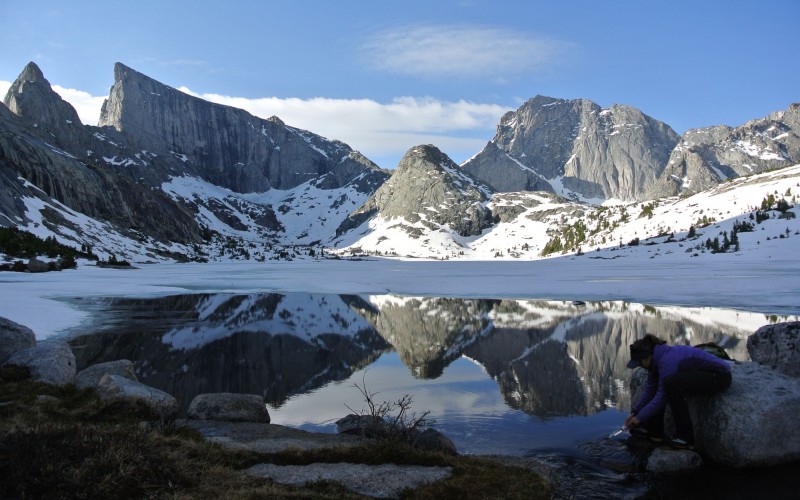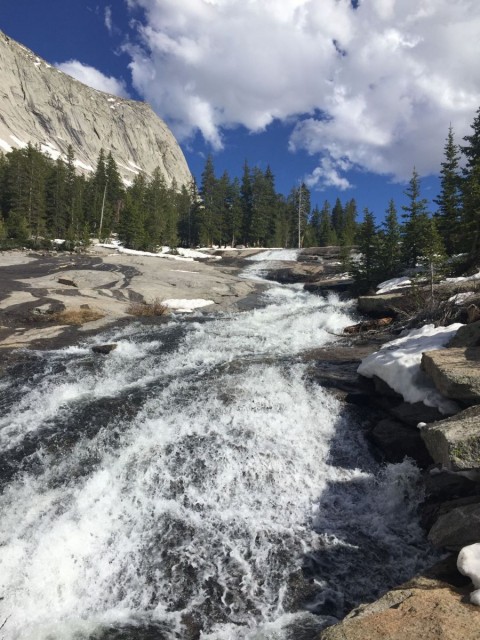
We hiked for a day to reach the trailhead. We spent another two days breaking trail through the snow to our camp. Then we repeated the trip to bring in the research equipment. It was May, and two research assistants and I had gone into the southern Wind River Mountains to collect water samples for four weeks at Deep Lake, a sublime cirque 10,000 feet above sea level.
I went to Wyoming’s high-country to find out if air pollution has changed this remote reach. Emissions from natural gas extraction already affect human health in the nearest town, Pinedale, Wyoming. I wanted to see if this wild place was also harmed.
 Deep Lake is a 10-mile hike up the valley from the Big Sandy Trailhead—a half-day if you move quickly. Pinedale, the nearest town, is over 50 miles away down a winding dirt road. In spring the trail is buried under snow. Even the road to the trailhead is a morass of snowdrifts and mud, impassable by truck, ATV or snowmobile. Try, and your car might end up mired for weeks. I know from experience. And though this is wilderness, humans are already changing it profoundly.
Deep Lake is a 10-mile hike up the valley from the Big Sandy Trailhead—a half-day if you move quickly. Pinedale, the nearest town, is over 50 miles away down a winding dirt road. In spring the trail is buried under snow. Even the road to the trailhead is a morass of snowdrifts and mud, impassable by truck, ATV or snowmobile. Try, and your car might end up mired for weeks. I know from experience. And though this is wilderness, humans are already changing it profoundly.
We went into the Wind River Range to investigate why hikers return from remote alpine lakes with reports of algal blooms. Lakes across the Rocky Mountains are eutrophfying from too much nitrogen. The blooms then starve other lake-life of oxygen. The nitrogen can come from different sources: ammonia released by agricultural fertilizers, nitrates emitted by combustion. Once aloft, winds blow these pollutants high into the mountains. Rising terrain pushes the air mass upward, and nutrients settle out of the clouds into headwater basins. The deposited nitrogen fertilizes—over-fertilizes—sensitive ecosystems. For now, changes are most easily tracked in lakes. On land, excess nitrogen can change what plants grow where. When food sources change, wildlife responds. And, as isolated as Deep Lake is, it forms a part of the headwaters of the Green River, the largest tributary to the Colorado. The effects of changing water chemistry may run through the watershed.
 Pollution starts upwind. And, just 25 miles southwest of our study site, millions of cubic feet of natural gas are extracted each day at the Jonas and Pinedale anticlines. They extract the gas in a few different ways, including hydraulic fracturing, or fracking. Burning excess gas released in fracking releases nitrous oxides, which forms nitric acid in water, or reacts with sunlight to form ozone. The ozone creates smog. On many days, the small town of Pinedale, WY, population 1,977, exceeds federal air quality limits and has smog levels higher than those of Los Angeles.
Pollution starts upwind. And, just 25 miles southwest of our study site, millions of cubic feet of natural gas are extracted each day at the Jonas and Pinedale anticlines. They extract the gas in a few different ways, including hydraulic fracturing, or fracking. Burning excess gas released in fracking releases nitrous oxides, which forms nitric acid in water, or reacts with sunlight to form ozone. The ozone creates smog. On many days, the small town of Pinedale, WY, population 1,977, exceeds federal air quality limits and has smog levels higher than those of Los Angeles.
I thought that air-born nitrogen could be accumulating in the mountain snowpack. When snow melts, I reasoned, it releases the nitrogen to the greater ecosystem through the waterways. My research assistants and I wanted to see if snowmelt water flowing into the lake had higher concentrations of nitrogen than water at the outlet, where it would be diluted by lake water. Similarly, we wanted to see if samples from the early summer, when snow melts the fastest, had higher concentrations of nitrogen than those from the late summer.
 So, every morning and evening, we collected samples from the inlet and outlet of the Deep Lake. In August, we used a lightweight inflatable raft to collect samples from the middle of the lake. Wind often blew us back and forth across the lake. Mostly, sampling was successful. Sometimes violent thunderstorms and avalanche risk prevented us from safely accessing the research site. “Planning is priceless, but plans are worthless,” I reminded myself.
So, every morning and evening, we collected samples from the inlet and outlet of the Deep Lake. In August, we used a lightweight inflatable raft to collect samples from the middle of the lake. Wind often blew us back and forth across the lake. Mostly, sampling was successful. Sometimes violent thunderstorms and avalanche risk prevented us from safely accessing the research site. “Planning is priceless, but plans are worthless,” I reminded myself.
One night, in early June, we stayed awake to collect samples every hour for 24-hours. It was a clear night, and the Milky Way dominated the landscape, reflecting off the snow and glowing through the basin. We shivered the night away in awe, watching the stars until sunrise radiated off East Temple Peak. The sheer granite face brightened, passing from steely gray to dusky purple, to pink and then orange and pale yellow. It posed a rainbow through the dawn.
I’ve spent well over 1,000 nights in the western backcountry. Cumulatively, I’ve lived over a year of my life in the Wind River Range. Now I work under the fluorescent lights of the stable isotope lab, carefully guiding precious samples through the Ion Chromatograph, Flow Analyzer, and Auto Titrator. I’m far from the granite spires and alpine sunsets of the Wind River range, but the data keeps me motivated. Each spreadsheet reveals one more clue to pollution patterns in the Wind River Ecosystem. As a scientist, I’m curious to see the results. As an advocate for wild places, I’m concerned.
